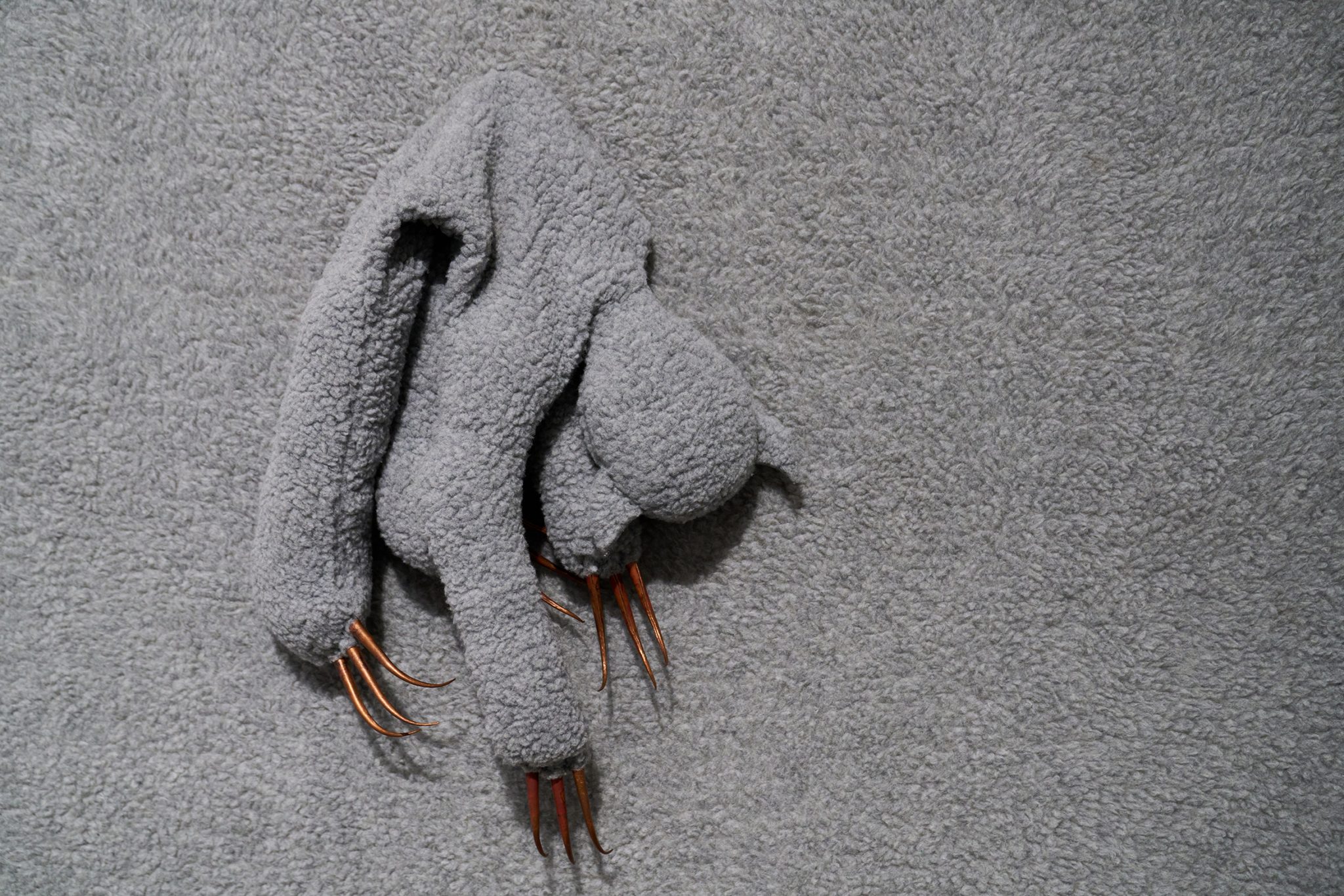The artist conjures cartoonish monsters under the bed in an exhibition that feels less nightmarish than disarmingly cuddly
Permindar Kaur’s latest exhibition, arranged across three galleries, broadly tackles the twin subjects of childhood and domesticity. In practice, that means creatures lurking under beds, monsters bursting out of walls, and chairs that appear to be walking or are otherwise terrifyingly high (accessed by a ladder). The opening gallery features a salon-style hang (that, in turn, projects a somewhat Victorian vibe) of works from the Camouflage series (2012–24). Featureless copper-clawed animals – perhaps some sort of comic cross between a sloth and a teddy bear – appear to bubble up out of panels of variously patterned fabric, captured just before what could be a full emergence. Like costumes mounted on the wall, they might be thought of as some sort of trophy (Antlers, 2016, four fabric trophy mounts crowned with steel antlers that are shaped like some baroque curlicue, literalises this association). The patterned colours, operating like some sort of dazzle camouflage, enhance the feeling of something there but not there: a trick of perception or the light. The feeling you get from looking at these fabric creatures was clearly the reason psychoanalysis was invented.
Untitled: Bed (2020) is a stripped-down bedframe underneath which nests a flock of colourful fabric globules, copper spikes protruding from their soft surfaces. Seen together, they’re reminiscent of a virus viewed under a microscope (unless that’s just the effect of viewing the work through the filter of viewing the work in this post-COVID moment). The true point, perhaps, is that you’re invited to project what you want onto them. As if the experience itself was designed to provoke some form of psychoanalytic self-knowledge. Albeit, thanks to the soft-toy allusions, reached in a safe, non-threatening way. Even if Green Figure (1995–2024), a fabric form reminiscent of (a flaccid interpretation of) the green signal on pedestrian crossings, ‘clad’ in copper boots and the copper outline of a Norman helmet (minimal, ineffectual armour), appears to have been hung out to dry next door.
The following room contains Hunting Chair (2024) a steel rendition of the high seats used by hunters in mainland Europe to await their prey. It’s been arranged so as to command a view through the windows of the John Hansard and out across the public square opposite, as if awaiting a person prepped for a deranged mass shooting event. Though in the gallery the principal danger seems to be that involving the scaling of its height. And, of course, there’s a narrative beginning to form: about how the trophy ends up on the wall (and perhaps about the relationship between violent fantasy and violence performed). All of which is offset by the colourful red-and-yellow daisies stencilled on the floor (Floor Flowers, 2024). As if the nightmare could be too hot to handle.
The final gallery is home to assemblies of inky black fabric figures that look like cartoonish, grape-flavoured, devil-horned jelly babies. Armoured Truck (2016) features a cluster of them that have been crushed into a copper cage; in Black Curtain (2015) a small army emerge from a piece of black fabric that might equally be a part of the Camouflage series. A solitary figure straddles what looks like an antler (Branch, 2016); while in the largest installation (Ten Teddies & Barrier, 2017), five pairs of the creatures sit as if talking, stand as if plotting and lie down as if dead, in a room divided by a steel barrier constructed from what look like giant nails. While there’s a palpable sense of no-go areas, conspiracy, surveillance and undercover goings-on at play here, it remains mitigated by the sensation that you’ve also stepped into a child-friendly world. You can imagine the gallery requesting that the fabric figures be repurposed as merchandise for the gift shop. And while that might be a jaded or cynical view of how such spaces operate, it nevertheless prevents the full horror of the forces with which the artist is engaging from being successfully unleashed.
Nothing is Fixed at John Hansard Gallery, Southampton, 8 June – 7 September
